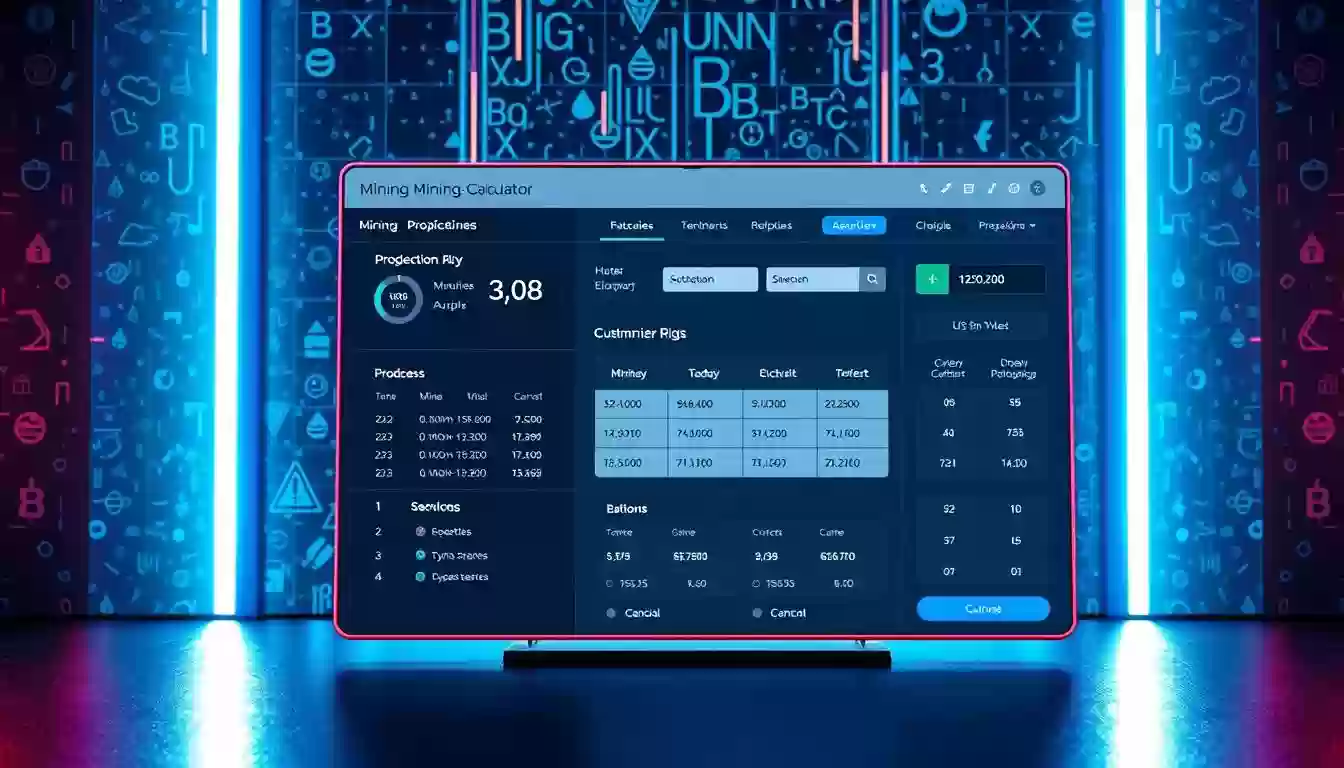Is Crypto Mining Profitable in 2025? Learn How to Calculate
 06 Mar 25
06 Mar 25
Crypto mining remains a hot topic in 2025, attracting both seasoned investors and newcomers. As the blockchain landscape evolves, understanding the factors that influence mining profitability is crucial for anyone considering this venture.
At its core, mining involves solving complex mathematical puzzles to validate transactions on the Bitcoin network. The reward for successfully mining a block is currently 3.125 BTC, a figure that halves every four years. However, the journey to achieving this reward involves significant computational power, measured in hash rates, and substantial energy consumption.
Using a reliable mining calculator is essential for determining potential profitability. These tools consider factors like hash rate, power consumption, and current BTC prices. For instance, a miner with a hash rate of 390.00 TH/s and 7,215 Watts consumption could see a daily profit of $11.38, highlighting the importance of accurate calculations.
This guide simplifies the technical aspects of mining, making it accessible to both beginners and intermediate users. By focusing on current data and real-world examples, we aim to provide a clear, educational path to understanding mining profitability in 2025.
Overview of Crypto Mining in 2025
The landscape of Bitcoin mining in 2025 reflects significant advancements and shifts in the industry. As the blockchain ecosystem matures, miners are adapting to new challenges and opportunities, driven by technological evolution and market demands.
Historical Trends and Industry Shifts
The journey from CPU mining to sophisticated ASIC miners marks a significant evolution. Early adopters relied on basic computer processors, but the rise of ASICs, such as Bitmain’s Antminer series, revolutionized the industry, offering unparalleled efficiency. These hardware advancements were complemented by the emergence of mining pools, which allowed individuals to combine their computational power, making mining more accessible and rewarding for smaller participants.
Changes in Bitcoin’s block reward and mining difficulty have been pivotal. The halving events, which reduce the block reward, have historically impacted profitability, encouraging miners to seek efficiency. Additionally, the shift from individual to pool mining, facilitated by mining calculators, has become essential for maximizing returns in a competitive landscape.
| Miner Model | Hash Rate | Power Consumption |
|---|---|---|
| Bitmain Antminer S19 Pro | 110 TH/s | 3250W |
| MicroBT WhatsMiner M30S+ | 100 TH/s | 3400W |
| StrongU STU-U1 | 52 TH/s | 2100W |
Current Market Dynamics
In 2025, the mining landscape is shaped by rising electricity costs and strategic investments. Companies like Hive Digital and Cipher Mining are expanding operations, investing in high-capacity facilities to capitalize on the growing demand. The price of Bitcoin remains a critical factor, with fluctuations directly impacting mining revenue.
For those considering mining, using a reliable Bitcoin mining calculator is essential to evaluate potential returns. These tools help miners assess factors like hash rate, power consumption, and current BTC prices, providing clarity in a competitive market.
Step-by-Step Guide to Calculate crypto mining profitability
Understanding how to assess the financial viability of Bitcoin mining is essential for both newcomers and experienced miners. This guide provides a clear, structured approach to evaluating your potential earnings.
Understanding Key Mining Metrics
To determine mining profitability, you need to focus on three critical factors:
- Hash Rate: The computational power of your mining device, measured in terahashes per second (TH/s). A higher hash rate increases your chances of solving blocks faster.
- Power Consumption: The energy your hardware uses, measured in watts (W). Lower consumption reduces electricity costs, boosting profit margins.
- Mining Difficulty: A network-adjusted value that reflects how hard it is to find a block. Higher difficulty means more computational effort is required.
Breaking Down Revenue, Costs, and Rewards
Your total revenue is based on the block reward and any pool fees. Costs include electricity and hardware expenses. Using a Bitcoin mining calculator simplifies these calculations:
- Block Reward: Currently 3.125 BTC per block, halving every four years.
- Pool Fees: Typically ranging from 1-3%, deducted from your earnings.
- Electricity Costs: Calculated by multiplying your device's power consumption by your local electricity rate (in USD per kWh).
Leveraging Online Mining Calculators
Using a reliable Bitcoin mining calculator is crucial for accurate profitability assessments. Here's how to get started:
- Input Your Hash Rate: Enter your device's hash rate (e.g., 390 TH/s).
- Enter Power Consumption: Provide your hardware's power usage (e.g., 7,215 Watts).
- Calculate Daily Profit: The calculator will show your estimated daily earnings in BTC and USD.

By following these steps and regularly updating your inputs with current market data, you can make informed decisions to maximize your mining earnings.
Essential Mining Hardware and Cost Considerations
When it comes to Bitcoin mining, the right hardware is crucial for achieving optimal results. Application-Specific Integrated Circuit (ASIC) miners are the backbone of modern mining operations, offering unparalleled performance and efficiency.
ASIC Miner Specifications and Performance
ASIC miners are designed specifically for Bitcoin mining, delivering high hash rates and efficient power consumption. For instance, the Bitmain Antminer S19 Pro boasts a hash rate of 110 TH/s and consumes 3250W of power, while the MicroBT WhatsMiner M30S+ offers 100 TH/s with a power consumption of 3400W. These specifications directly impact your mining profitability, as higher hash rates increase your chances of solving blocks faster.
Electricity Costs and Power Consumption
Power consumption is a critical factor in determining mining profitability. Miners should consider both the initial hardware costs and ongoing electricity expenses. The cost of electricity varies significantly by location, with regions like Iceland and Canada offering competitive rates. Balancing these costs is essential to ensure long-term profitability.
| Miner Model | Hash Rate | Power Consumption | MSRP |
|---|---|---|---|
| Bitmain Antminer S19 Pro | 110 TH/s | 3250W | $5,000 |
| MicroBT WhatsMiner M30S+ | 100 TH/s | 3400W | $6,000 |
| StrongU STU-U1 | 52 TH/s | 2100W | $3,800 |
For those interested in learning more about mining hardware and costs, this guide provides comprehensive insights.
In conclusion, selecting the right ASIC miner and understanding electricity costs are vital for maximizing your mining profit. Always use a reliable mining calculator to ensure accurate profitability assessments and make informed decisions.
Exploring Bitcoin Mining and Profit Forecasts
As we delve into the future of Bitcoin mining, understanding the financial forecasts and reward structures becomes essential for anyone considering this venture. The interplay between block rewards, mining difficulty, and hash rates lays the groundwork for predicting profitability.
Mining Reward Estimates and Block Rewards
Bitcoin mining rewards are calculated based on solving complex puzzles to validate transactions. The current block reward is 3.125 BTC, halving every four years. This reduction, known as the halving event, impacts profitability, encouraging miners to optimize operations. Mining difficulty adjusts every two weeks to maintain a consistent block time of 10 minutes, affecting how quickly miners can find blocks and earn rewards.
Insights from the Bitcoin Mining Calculator
Using a Bitcoin mining calculator provides a clear view of potential earnings. For example, a miner with a hash rate of 390 TH/s and power consumption of 7,215 Watts can expect a daily profit of $11.38. This calculation factors in electricity costs, pool fees, and current BTC prices, offering a realistic outlook on mining profitability.
Weekly forecasts estimate earnings around $79.71, monthly at $347.79, and annually at $4,173.48, based on consistent operations. These figures highlight the importance of regular monitoring and adjustments to maintain profitability in a competitive market.
By leveraging these tools and staying informed, miners can make data-driven decisions to optimize their strategies and maximize returns in the evolving landscape of Bitcoin mining.
Optimizing Your Mining Strategy in 2025
As Bitcoin mining continues to evolve, optimizing your strategy is key to maximizing efficiency and returns. Whether you're a seasoned miner or just starting out, adopting best practices can significantly impact your bottom line.
Key Tips for Efficient Mining Operations
Start by focusing on reducing electricity costs, which can be one of your largest expenses. Consider relocating to areas with lower energy rates or investing in renewable energy sources like solar or wind power. Additionally, fine-tune your hardware settings. For example, adjusting the voltage on your ASIC miners to optimal levels (e.g., 0.7-0.9V) can enhance performance without increasing power consumption.
Choosing the right mining pool is another critical step. Look for pools with low fees and high hash rates to ensure better rewards. Regularly monitoring your operations with a reliable Bitcoin mining calculator will help you stay updated on potential earnings and adjust your strategy as needed.

Finally, stay informed about market trends and network changes. With the halving event approaching, understanding its impact on block rewards and mining difficulty is essential. By combining these strategies, you can create a sustainable and profitable mining operation in 2025.
Conclusion
As we explore the future of Bitcoin mining in 2025, it's clear that understanding key metrics like hash rate, power consumption, and mining difficulty is essential for success. By leveraging a reliable Bitcoin mining calculator, you can accurately assess potential earnings and make informed decisions.
Key takeaways include:
- Regularly monitor mining metrics and adjust strategies as needed.
- Invest in efficient hardware to maximize hash rates while minimizing power consumption.
- Stay informed about market trends and network changes, such as the halving event and rising mining difficulty.
With the right tools and a proactive approach, miners can navigate the evolving landscape and optimize their operations for long-term success. Use the insights and tools provided in this guide to make data-driven decisions and stay ahead in the competitive world of Bitcoin mining.
FAQ
What is the current profitability of Bitcoin mining?
The profitability of Bitcoin mining depends on several factors, including your hash rate, electricity cost, and the current Bitcoin price. Using a Bitcoin mining calculator can help you estimate your potential earnings based on these variables.
How do I calculate my mining profitability?
To calculate your mining profitability, you can use a mining profitability calculator. These tools require inputs like your hash rate, power consumption, electricity cost, and the current Bitcoin price. They then provide an estimate of your daily, weekly, or monthly earnings.
What is a hash rate, and why is it important?
Your hash rate measures how quickly your mining hardware can solve the complex mathematical problems required to validate transactions on the Bitcoin network. A higher hash rate increases your chances of successfully mining a block and earning the block reward.
How does electricity cost impact mining profitability?
Electricity cost is one of the largest expenses for Bitcoin mining. Miners with access to low-cost electricity can significantly reduce their operational expenses, increasing their overall mining profitability. Always consider your power consumption and local electricity rates when planning your mining operations.
What is mining difficulty, and how does it affect my earnings?
Mining difficulty is a measure of how hard it is to find a hash below a given target. As more miners join the network, the difficulty increases, making it harder to mine blocks and reducing individual earnings. This is why it's important to regularly check the mining difficulty and adjust your strategy accordingly.
Can I mine Bitcoin without specialized hardware?
While it's technically possible to mine Bitcoin with a computer CPU or GPU, the process is highly inefficient compared to using specialized ASIC miners. For any serious mining operation, investing in ASIC hardware is recommended to maximize your hash rate and profitability.
How do I choose the right mining pool?
When selecting a mining pool, consider factors such as the pool's size, fees, payout structure, and reliability. Larger pools offer more consistent rewards but may have higher fees, while smaller pools may offer lower fees but less frequent payouts. Always research the pool's reputation before joining.
What is the block reward, and how is it calculated?
The block reward is the number of new Bitcoins awarded to miners for successfully validating a block of transactions. As of now, the block reward is 6.25 BTC per block. This reward is halved approximately every four years as part of Bitcoin's monetary policy, which is designed to control inflation and maintain scarcity.
How do I estimate my mining revenue using a Bitcoin mining calculator?
To estimate your mining revenue, input your hash rate, power consumption, electricity cost, and the current Bitcoin price into a Bitcoin mining calculator. The calculator will provide an estimate of your daily, weekly, or monthly earnings based on these inputs and the current network difficulty.
What are the main costs associated with Bitcoin mining?
The main costs associated with Bitcoin mining include the initial investment in mining hardware, ongoing electricity costs, and potential maintenance or repair costs. These expenses should be carefully considered when evaluating the profitability of your mining operation.
How often does the mining difficulty change?
The mining difficulty is adjusted approximately every two weeks, or with each new block (every 10-15 minutes). This adjustment ensures that the average time to mine a block remains around 10 minutes, maintaining the stability and security of the Bitcoin network.





























